1/32 Hasegawa/Alley Cat Ki.100-1b
In March 1945, B-29 crews began reporting the appearance of a previously-unknown type of Japanese Army fighter appearing in squadron strength at altitude over Japan. The new radial-engined fighter had superb maneuverability and high altitude performance.
In truth, the “new” Kawasaki Ki.100-I Army Type 5 Fighter was the most remarkable improvisation to be used by any combatant in the Second World War.
By 1944, production of the Kawasaki Ha‑40, the Japanese adaptation of the German Daimler‑Benz DB 601 engine, had all but failed completely, and many of those engines that were produced did not achieve their stated performance. Not only that, but the Ha-140 which was to replace the Ha-40 had been revealed as a complete failure. This made for a very difficult situation for the JAAF, since the fighter that used these engines, the Ki.61 Hien, was one of the few JAAF fighters capable of meeting the new threat of high altitude raids over Japan by the B-29, which had entered the war in strength when missions began to be flown from the Marianas that November.
This was particularly important because the Ki.61-II-KAI, which had been introduced into production that fall, was an improved model that would have been more capable of taking on the F6 Hellcat, F4U Corsair and P-51 Mustang, powered by the new 1,500 hp Kawasaki Ha‑140 engine. Unfortunately, the Ha-140 never lived up to its design specifications, with the majority of engines produced either being rejected on quality grounds or failing in use.
Looking around for an engine of equivalent power that was more dependable, Kawasaki presented the JAAF with a proposal to power these airframes with a 1,500 hp Mitsubishi Ha‑112‑II Kinsei 60, a 14‑cylinder, two‑row radial engine developed for the Japanese Navy; such was the crisis, traditional Army-Navy rivalry was forgotten in the decision to make use of this engine. The necessary redesign to successfully mate a narrow fuselage designed for an inline powerplant with a radial engine took most of November and December 1944. The desperate need for the re‑engined fighter became even more urgent on January 19, 1945, when a B‑29 raid destroyed the Ha-140 production plant. Some 280 finished Ki.61-IIs were left without a powerplant.
Kawasaki's chief engineer, Takeo Doi, his assistant Makato Owada, and Tomio Oguchi, head of engine systems, worked through several concepts for redesigning the Ki‑61 airframe to accept the new engine. They relied on close study of a Fw-190A, which was remarkable for its closely-cowled radial. They finally settled on a solution which involved a second skin fairing being riveted to the fuselage to smooth out the airflow behind the adjustable cooling flaps, and multiple exhaust stubs of the new engine cowling. In fact, these ejector stubs did add approximately 10-12 mph to the top speed.
The first of three prototypes, know designated Ki.100-I, flew on February 1, 1945. The new engine gave perfect performance, and even increased the rate of climb and maneuverability of the airframe, though the top speed - a respectable 380 mph - was not as much as hoped. Best of all, this performance did not fall off as much at high altitude as did other Japanese fighters, though there was a demonstrated need for a superior two-stage supercharger. Armament was two fuselage‑mounted 20 mm Ho‑5 cannons, each with 200 rpg, with two wing‑mounted 12.7 mm Ho‑103 machine guns with 250 rpg.
The emergency measure of adapting the Ki.61‑II‑KAI fighter to carry a Mitsubishi radial engine had resulted in one of the best interceptors used by the Army during the entire war. Of equal importance to its performance, the fighter was easy to fly, and - like the Ki.84 - could make a good pilot a superior pilot.
Remarkably, the Ki.100-I was quickly issued to the 5th Sentai, and missions began in early March 1945, only five weeks after the first prototype's flight. The modification tempo increased such that by late April 1945, nearly all Sentais using the Ki.61 had been at least partially-equipped with the Ki.100-I, and 271 airframes had been so modified between March and June, 1945.
In June 1945, the Ki.100-Ib appeared. This was modified from the Ki.61-III airframe that entered production in early 1945, and featured a cut-down rear fuselage, and a 360-degree canopy. Only 118 of these superior versions were produced before the Kagamigahara factory was finally destroyed by B-29s in late July, 1945, with only 15 Ki.100-Ib's delivered that month.
Although there were far fewer Ki.100s available than Ki.84s, the JAAF saw the airplane as one of the most important fighters in the inventory. In late March and April 1945, experienced instructors from the Akeno Army Flying School flew the Ki.100 in extensive tests against the Ki.84, considered to be the best JAAF fighter in operational service. Their conclusions were that, given pilots of equal experience, the Ki.100 would always win.
The Ki.100 first entered combat on the night of March 9, 1945, during the first great Tokyo fire raid. The first loss occurred on April 7, 1945, when the Ki.100 flown by Master Sergeant Yasuo Hiema of the 18th Sentai was shot down by a B‑29 after "attacking the formation again and again".
One of the most astounding demonstrations of the superiority of the Ki.100-Ib occurred on July 18, 1945, when 12 Ki.100s led Major Yohei Hinoki, lead instructor of the Akeno fFighter School attacked a flight of the 506th Fighter Group over Nagoya. Hinoki, the “Japanese Douglas Bader,” flew with a wooden leg after a combat with a P-51A flown by future ace Robert Mulhollem over Rangoon in November, 1943. The 506th FG and the 21st FG had sortied from Iwo Jima on a long range mission to strafe airfields in the Nagoya region. Hinoki's fighter had such severe propeller vibration that during the combat he could not use his gunsight, and shot down Captain Robert Benbow from a range of less than 100 feet. The Akeno instructors shot down 4 P-51Ds that day without loss to themselves.
The well-known 244th Sentai received 24 of the Ki.100-Ib fighters in mid-July, after the unit had relocated from the Tokyo metropolitan area to southern Kyushu in preparation for the coming invasion everyone expected.
On July 25, 1945, 18 Ki.100s of the 244th Sentai ran across ten F6F-5 Hellcats from VF-31, operating from the USS Belleau Wood off the coast of Kyushu. In the subsequent air battle, the Japanese claimed 12 victories with only two losses. Claims and counter‑claims regarding the "true" results have resulted in later years with agreement that the actual losses were two Hellcats and two Ki.100s, including the Ki.100 flown by Major Tsutae Obara, which collided with the Hellcat flown by Ensign Edwin White, killing both pilots. The Hellcat pilots were unanimous in stating this was the most difficult fight any of them had been in.
The last Ki.100 to be shot down was the Ki.100-Ib flown by Sergeant Major Fumihiko Tamagake of the 244th Sentai, which was shot down by a P-51D on August 14, 1945, a day before the surrender of Japan.
Post-war testing revealed that a well‑handled Ki.100-Ib could out‑maneuver any American fighter including the P‑51D Mustang and the P‑47N Thunderbolt, and could hold its own with the F8F Bearcat.
THE KIT
This conversion set for the Ki.100-Ib provides 20 resin parts and six clear resin parts, including a complete new fuselage, under fuselage section with integral wing spar, engine, propeller blades, spinner, chin radiator, rear cockpit deck parts, 3 part clear cast canopy, new clear wing tip lights, separate rudder, correct gun bay covers (since not all kits are of the proper Ki.61-Ib, with machine gun wing armament).
Personal marking decals are provided for Ki.100-Ibs flown by Major Hinoki of the Akeno Flying School, Major Teruhiko Kobayashi, commander of the 244th Sentai, and Major Yasuhida Baba of the 5th Sentai. The rest of the decals are taken from the donor kit.
CONSTRUCTION
This is a straightforward “drop fit” conversion, and any modeler with experience of building eastern European limited-run kits should have no difficulty producing a very nice model.
I began construction by cleaning up the resin parts, since the kit had quite a bit of flash. I then test-fitted the fuselage parts and filed and sanded the mating areas as necessary to insure a good fit. With all that done, I painted the engine and attached it to one fuselage half. I then attached the exhaust stubs, and glued the fuselage halves together. I finished off by attaching the front of the cowling, and the plastic part from the donor kit for the tailwheel assembly. I filled all the gaps with cyanoacrylate glue, then followed that with liberal applications of Tamiya's “Mr. Surfacer” plastic putty. I next assembled the wings and horizontal stabilizers and set everything aside to set up.
I painted and assembled the kit cockpit per instructions, adding in an Eduard JAAF photoetch seat belt. When this was finished, I slid it into position in the fuselage, and then attached the wing spar and lower fuselage section. This last required quite a bit of test-fitting and modification to get a good fit, which was not unexpected and presented no difficulty.
Before assembling all the subassemblies, I sanded the fuselage seams smooth, giving them all a second coat of “Mr. Surfacer” and re-sanding. Since the resin was a bit “rough” to the touch, I sanded down the entire fuselage assembly with fine-grit Wet ‘r' Dry, then applied Tamiya rubbing compound and buffed it out with my Dremel. I then rescribed panel lines where necessary.
The spinner was assembled and seams filled, then the prop blades were glued in position.
With careful test-fitting, the wings fitted easily and I only needed some “Mr. Surfacer” on the upper fuselage-wing seam. The horizontal stabilizers also went on without difficulty.
COLORS & MARKINGS
Painting:
The Ki.100-Ib came in any variation of Japanese Army Green upper surfaces with unpainted aluminum lower surfaces, and Japanese Army Grey fabric control surfaces, with yellow wing leading edges, that one cares to apply. I first painted the yellow area on the wing leading edges and masked it off, then painted the lower areas of the control surfaces with Tamiya “J.A. Grey,” and masked them off. I painted the lower surfaces with Tamiya “Flat Aluminum,” then applied a light coat of Talon “Aluminum” to give a good metallic finish. The upper surfaces were painted Tamiya “J.A. Green,” which I lightly post-shaded. These airplanes were practically new still at the end of the war, and photos show them in good condition, so not a lot of “fading” was needed, just enough to not have a totally-monochromatic surface. The prop and spinner was painted with Tamiya “Flat Red-Brown.” I finished off with a couple coasts of Xtracrylix Gloss Varnish.
Decals:
This is the one area I encountered difficulty. Had I chosen to do the Akeno Flying School airplane or the 5th Sentai airplane, I would have had no problem, since these personal markings all include white, with other colors printed over that, and the white decal is sufficiently opaque to use on a dark colored surface, so there are no problems with these markings. Unfortunately, the yellow stripe and the red of the Sentai insignia for the 244th Sentai airplane are not sufficiently opaque. I was able to substitute a Sentai insignia from a Lifelike Decals sheet, and a yellow stripe from the decal dungeon. Alley Cat has told me that the next batch of decals will be printed with sufficient opacity to solve this problem. I also had to use Solvaset to get the kit decals to settle down in the panel lines.
FINAL CONSTRUCTION
I gave the model two coats of Xtracrylix Flat Varnish on the painted surfaces, leaving the aluminum surface alone other than to varnish the insignias and the flying surfaces. Since these airplanes were not “dinged” I only applied exhaust staining and gunfire staining, to create a model of the airplane as it might have appeared after the combat with VF-31 on July 25, 1945.
I then unmasked the canopy and attached the sliding section in the open position. The Alley Cat canopy is designed to be used only in the closed position, so I substituted the kit canopy part that can be posed open. I attached the landing gear and prop, and all was finished.
CONCLUSIONS
It's likely that Hasegawa will eventually do the Ki.100 series, given the design of the Ki.61 kit and the company's history of “maximizing value” of the molds. When this might happen is anyone's guess, but I would bet on it not happening soon, given their recent history. For modelers who want to have a Ki.100 in their collection, these conversion kits by Alley Cat are excellent value, and are not at all hard to use by a modeler with any successful experience of limited-run kits. This Ki.100 looks great sitting next to my Ki.61-Ib and Ki.61-Ic models.

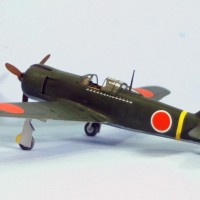
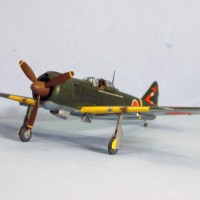
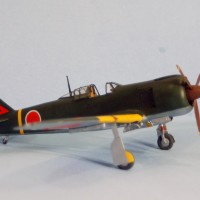
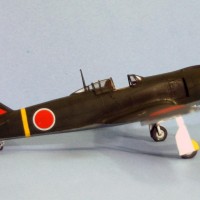
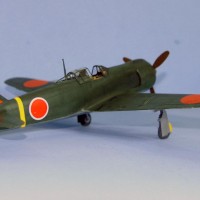
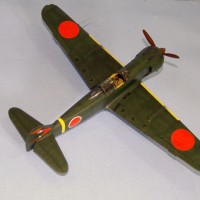

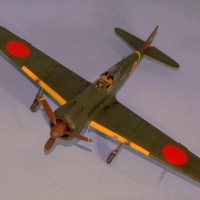
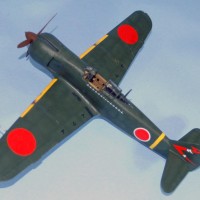


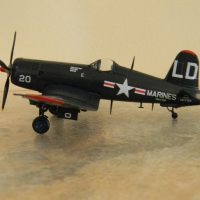

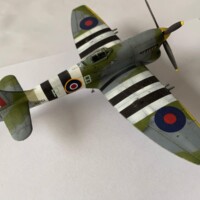
Nice job, TC
Another first for you, Tom- looks great! At least it's the only one I've seen built thus far. Of all the conversion sets out there, it seems like Alley Cat really does a good job matching their surfaces with those of the donor kit.
I've been craving the Ki-100 set, but if I ever build one then I suppose I'll still be tempted to do something with the Hasegawa Ki-61 fuselage since the plastic is so nice. Like a wreck vignette or something.
In my experience, you can pretty much trust anything AtoZee does with any of their sets. Alastair is a real craftsman. I did his wingfold for a 1/72 Gannet and was amazed by it. The drop-fit Ki.100 and Bf-109 conversions are superb.